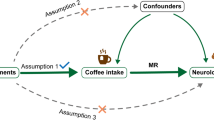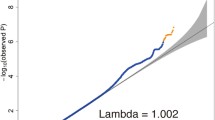Abstract
This study examined whether coffee consumption is causally associated with osteoarthritis. A two-sample Mendelian randomization (MR) analysis using inverse-variance weighted (IVW) and weighted median estimates, and the MR-Egger regression method were performed. The publicly available summary statistical datasets of coffee consumption genome-wide association studies (GWASs) meta-analyses on coffee intake from eight Caucasian cohorts (n = 18,176), GWAS meta-analyses of predominately regular-type coffee consumers of European ancestry (n = up to 91,462), and a GWAS in 7410 patients with osteoarthritis in the arcOGEN study with 11,009 controls of European ancestry were evaluated. Four single-nucleotide polymorphisms (SNPs) from GWASs of coffee consumption as instrumental variables (IVs) to improve inference were selected. These SNPs were located at neurocalcin delta (NCALD) (rs16868941), cytochrome p450 oxidoreductase (POR) (rs17685), cytochrome p450 family 1 subfamily A member 1 (CYP1A1) (rs2470893), and neuronal cell adhesion molecule (NRCAM) (rs382140). The IVW method (beta = 0.381, SE = 0.170, p = 0.025) and the weighted median approach (beta = 0.419, SE = 0.206, p = 0.047) showed evidence to support a causal association between coffee consumption and osteoarthritis. MR-Egger regression revealed that directional pleiotropy was unlikely to be biasing the result (intercept = 0.064; p = 0.549), but showed no causal association between coffee consumption and osteoarthritis (beta = − 0.518, SE = 1.270, p = 0.723). Cochran’s Q test and the funnel plot indicated no evidence of heterogeneity between IV estimates based on the individual variants. The results of MR analysis support the observation that coffee consumption is causally associated with an increased risk of osteoarthritis.



Similar content being viewed by others

References
Dieppe PA, Lohmander LS (2005) Pathogenesis and management of pain in osteoarthritis. Lancet 365:965–973
Litwic A, Edwards MH, Dennison EM, Cooper C (2013) Epidemiology and burden of osteoarthritis. Br Med Bull 105:185–199
Kim D, Cho S-K, Nam SW, Kwon HH, Jung S-Y, Jeon CH, Im SG, Kim D, Jang EJ, Sung Y-K (2017) Cardiovascular and gastrointestinal effects of Etoricoxib in the treatment of osteoarthritis: a systematic review and network meta-analysis. J Rheum Dis 24:293–302
Choi HK, Curhan G (2010) Coffee consumption and risk of incident gout in women: the nurses’ health study. Am J Clin Nutr 92:922–927
Graham D (1978) Caffeine—its identity, dietary sources, intake and biological effects. Nutr Rev 36:97–102
Cohen NP, Foster RJ, Mow VC (1998) Composition and dynamics of articular cartilage: structure, function, and maintaining healthy state. J Orthop Sports Phys Ther 28:203–215
Luo H, Li J, Cao H, Tan Y, Magdalou J, Chen L, Wang H (2015) Prenatal caffeine exposure induces a poor quality of articular cartilage in male adult offspring rats via cholesterol accumulation in cartilage. Sci Rep 5:17746
Tan Y, Liu J, Deng Y, Cao H, Xu D, Cu F, Lei Y, Magdalou J, Wu M, Chen L (2012) Caffeine-induced fetal rat over-exposure to maternal glucocorticoid and histone methylation of liver IGF-1 might cause skeletal growth retardation. Toxicol Lett 214:279–287
Giustina A, Mazziotti G, Canalis E (2008) Growth hormone, insulin-like growth factors, and the skeleton. Endocr Rev 29:535–559
Wong THT, Sui Z, Rangan A, Louie JCY (2017) Discrepancy in socioeconomic status does not fully explain the variation in diet quality between consumers of different coffee types. Eur J Nutr:1–9
Burgess S, Daniel RM, Butterworth AS, Thompson SG, Consortium E-I (2014) Network Mendelian randomization: using genetic variants as instrumental variables to investigate mediation in causal pathways. Int J Epidemiol 44:484–495
Lawlor DA (2016) Commentary: two-sample Mendelian randomization: opportunities and challenges. Int J Epidemiol 45:908–915
Amin N, Byrne E, Johnson J, Chenevix-Trench G, Walter S, Nolte I, Vink J, Rawal R, Mangino M, Teumer A (2012) Genome-wide association analysis of coffee drinking suggests association with CYP1A1/CYP1A2 and NRCAM. Mol Psychiatry 17:1116–1129
Cornelis MC, Byrne EM, Esko T, Nalls MA, Ganna A, Paynter N, Monda KL, Amin N, Fischer K, Renstrom F (2015) Genome-wide meta-analysis identifies six novel loci associated with habitual coffee consumption. Mol Psychiatry 20:647–656
Consortium a (2012) Identification of new susceptibility loci for osteoarthritis (arcOGEN): a genome-wide association study. Lancet 380:815–823
Thorgeirsson TE, Gudbjartsson DF, Surakka I, Vink JM, Amin N, Geller F, Sulem P, Rafnar T, Esko T, Walter S (2010) Sequence variants at CHRNB3–CHRNA6 and CYP2A6 affect smoking behavior. Nat Genet 42:448–453
Burgess S, Butterworth A, Thompson SG (2013) Mendelian randomization analysis with multiple genetic variants using summarized data. Genet Epidemiol 37:658–665
Hartwig FP, Davies NM, Hemani G, Davey Smith G (2016) Two-sample Mendelian randomization: avoiding the downsides of a powerful, widely applicable but potentially fallible technique. Oxford University press, pp
Pierce BL, Burgess S (2013) Efficient design for Mendelian randomization studies: subsample and 2-sample instrumental variable estimators. Am J Epidemiol 178:1177–1184
Bowden J, Davey Smith G, Burgess S (2015) Mendelian randomization with invalid instruments: effect estimation and bias detection through Egger regression. Int J Epidemiol 44:512–525
Burgess S, Thompson SG (2017) Interpreting findings from Mendelian randomization using the MR-Egger method. Eur J Epidemiol 32:377–389
Bowden J, Davey Smith G, Haycock PC, Burgess S (2016) Consistent estimation in Mendelian randomization with some invalid instruments using a weighted median estimator. Genet Epidemiol 40:304–314
Hemani G, Zheng J, Wade K, Elsworth B, Langdon R, Burgess S (2016) MR-Base: a platform for systematic causal inference across the phenome using billions of genetic associations. Biorxiv 16:78972
Egger M, Smith GD, Phillips AN (1997) Meta-analysis: principles and procedures. BMJ 315:1533–1537
Cornelis M (2012) Coffee intake. Prog Mol Biol Transl Sci 108:293–322. 10.1016. B978–0–12-398397-8.00012-5
Hill HA, Kleinbaum DG (2000) Bias in observational studies. Encyclopedia of Biostatistics
Lee YH, Bae SC, Song GG (2013) Hepatitis B virus (HBV) reactivation in rheumatic patients with hepatitis core antigen (HBV occult carriers) undergoing anti-tumor necrosis factor therapy. Pp
Smith GD, Ebrahim S (2008) Mendelian randomization: genetic variants as instruments for strengthening causal inference in observational studies
Thompson JR, Minelli C, Bowden J, Del Greco FM, Gill D, Jones EM, Shapland CY, Sheehan NA (2017) Mendelian randomization incorporating uncertainty about pleiotropy. Stat Med 36:4627–4645
Paaby AB, Rockman MV (2013) The many faces of pleiotropy. Trends Genet 29:66–73
Smith GD, Ebrahim S (2004) Mendelian randomization: prospects, potentials, and limitations. Int J Epidemiol 33:30–42
Burgess S, Dudbridge F, Thompson SG (2016) Combining information on multiple instrumental variables in Mendelian randomization: comparison of allele score and summarized data methods. Stat Med 35:1880–1906
Swerdlow DI, Kuchenbaecker KB, Shah S, Sofat R, Holmes MV, White J, Mindell JS, Kivimaki M, Brunner EJ, Whittaker JC (2016) Selecting instruments for Mendelian randomization in the wake of genome-wide association studies. Int J Epidemiol 45:1600–1616
Burgess S, Thompson SG, Collaboration CCG (2011) Avoiding bias from weak instruments in Mendelian randomization studies. Int J Epidemiol 40:755–764
Acknowledgements
This research received no specific grants from any public, commercial, or not-for-profit sector funding agencies.
Author information
Authors and Affiliations
Corresponding author
Ethics declarations
Disclosures
None.
Rights and permissions
About this article
Cite this article
Lee, Y.H. Investigating the possible causal association of coffee consumption with osteoarthritis risk using a Mendelian randomization analysis. Clin Rheumatol 37, 3133–3139 (2018). https://doi.org/10.1007/s10067-018-4252-6
Received:
Revised:
Accepted:
Published:
Issue Date:
DOI: https://doi.org/10.1007/s10067-018-4252-6



